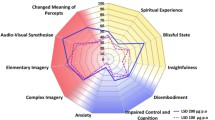Abstract
In order to assess the role played by serotonin (5-HT) in subjective anxiety, three groups of 12 healthy volunteers were given 12 mg metergoline (MET), 10 mg diazepam (DZ) or placebo (PB), under double-blind conditions, and submitted to a simulated public speaking (SPS) test. MET increased state-anxiety scores, measured by Spielberg's State-Trait Anxiety Inventory. The effect of MET was significantly different from both the PB and DZ groups immediately before the SPS test (prestress) as well as 24 h after medication, and from the DZ group only, 2.5 h after the test (poststress). In contrast, DZ did not significantly affect subjective anxiety. The SPS test significantly increased anxiety in DZ- or PB-treated subjects as compared to prestress scores, whereas the increases in the MET group were not significant, probably because pretest levels were already high. No drug effect on heart rate, skin electrical conductance and quality of sleep during the night following medication was found. In addition, the drugs did not cause bodily symptoms that could secondarily affect mood. Since MET is a 5-HT receptor antagonist, active on the central nervous system, an inhibitory role of 5-HT on subjective anxiety might be suggested.
Similar content being viewed by others
References
Ansseau M, Doumont A, Thiry D, Gelders Y (1983) Pilot study of a specific serotonergic antagonist, piremperone, in the treatment of anxiety disorders. Acta Psychiat Belg 83:517–524
Beretta C, Ferrini R, Glässer AH (1965) 1-Methyl-8β-carbobenzyloxy-aminomethyl-10-α-ergoline, a potent and long-lasting 5-hydroxytryptamine antagonist. Nature 207:421–422
Biaggio AMB, Natalício L, Spielberger CD (1976) The development and validation of an experimental portuguese form of the state-trait anxiety inventory. In: Spielberger CD, Diaz-Guerrero R (eds) Cross-cultural research on anxiety. Hemisphere/Wiley, Washington, DC, p 29
Bloomfield SS, Tetreault L, Lafrenière B, Bordeleau JM (1967) A method for the evaluation of hypnotic agents in man. Comparative hypnotic effects of secobarbital, methaqualone and placebo in normal subjects and in psychiatric patients. J Pharmacol Exp Ther 156:375–382
Commissaris RL, Rech RH (1982). Interactions of metergoline with diazepam, quipazine, and hallucinogenic drugs on a conflict behavior in the rat. Psychopharmacology 76:282–285
Cook L, Sepinwall J (1975) Reinforcement schedules and extrapolations to humans from animals in behavioral pharmacology. Fed Proc 34:1889–1897
Falsetti L, Voltolini AM, Schimberni M, Pontiroli AE (1983) Treatment of hyperprolactinaemia with metergoline for periods up to 5 years: clinical and biological tolerability. Curr Med Res Op 8:327–332
Fuxe K, Agnati L, Everitt B (1975) Effects of metergoline on central monoamine neurons. Evidence for a selective blockade of central 5-HT receptors. Neurosci Lett 1:283–291
Graeff FG (1981) Minor tranquilizers and brain defense systems. Brazilian J Med Biol Res 14:239–265
Graeff FG (1984) The anti-aversive action of minor tranquilizers. TIPS 5:230–233
Graeff FG, Rawlins JNP (1980) Dorsal periaqueductal gray punishment, septal lesions and the mode of action of minor tranquilizers. Pharmacol Biochem Behav 12:41–45
Gray JA (1982) The neuropsychology of anxiety: An enquiry into the functions of the septo-hippocampal system. Oxford University Press, New York
Hamon M, Mallat M, Herbert A, Nelson DL, Audinot M, Pichat L, Glowinski J (1981) [3H] Methergoline: A new ligand of serotonin receptors in the rat brain. J Neurochem 36:613–626
Invernizzi R, Samanin R (1981) Effects of methergoline on regional serotonin metabolism in the rat brain. Pharmacol Res Commun 13:511–516
Iversen SD (1984) 5-HT and anxiety. Neuropharmacology 23 SI: 1553–1560
Kilts CD, Commissaris RL, Cordon JJ, Rech RH (1982) Lack of central 5-hydroxytryptamine influence on the anticonflict activity of diazepam. Psychopharmacology 78:156–164
Leone CML, De Aguiar JC, Graeff FG (1983) Role of 5-hydroxytryptamine in amphetamine effects on punished and unpunished behavior. Psychopharmacology 80:78–82
Leysen JE, Awouters F, Kennis L, Laduron PM, Vanderberk J, Janssen PAJ (1981) Receptor binding profile of R 41468, a novel antagonist at 5-HT2 receptors. Life Sci 28:1015–1022
Martini A, Moro E, Marrari P, Pacciarini MA, Sega R, Dell'Osso L, Bertelli Jr A, Tamassia V (1983) Pharmacokinetics and bioavailability of metergoline in healthy volunteers after single i.v. and oral administration. Int J Clin Pharmacol Res 3: 27–34
McNair DM, Frankenthaler LM, Czerlinsky T, White TW, Sasson S, Fisher S (1982) Simulated public speaking as a model of clinical anxiety. Psychopharmacology 77:7–10
Morato de Carvalho S, De Aguiar JC, Graeff FG (1981) Effect of minor tranquilizers, tryptamine antagonists and amphetamine on behavior punished by brain stimulation. Pharmacol Biochem Behav 15:351–356
Petersen EN, Lassen JB (1981) A water lick conflict paradigm using drug experienced rats. Psychopharmacology 75:236–239
Sastry BSR, Phillis JW (1977) Metergoline as a selective 5-hydroxytryptamine antagonist in the cerebral cortex. Can J Physiol Pharmacol 55:130–133
Shephard RA, Buxton DA, Broadhurst PL (1982) Drug interactions do not support reduction in serotonin turnover as the mechanism of action of benzodiazepines. Neuropharmacology 21:1027–1032
Schütz MTB, De Aguiar JC, Graeff FG (1985) Anti-aversive role of serotonin in the dorsal periaqueductal grey matter. Psychopharmacology (in press)
Spielberg CD, Gorsuch RL, Lushene RE (1970) Manual for the state-trait anxiety inventory. Consulting Psychologists Press, Palo Alto, California
Thiébot M-H, Soubrié P, Hamon M, Simon P (1984) Evidence against the involvement of serotonergic neurons in the antipunishment activity of diazepam in the rat. Psychopharmacology 82:355–359
Author information
Authors and Affiliations
Rights and permissions
About this article
Cite this article
Graeff, F.G., Zuardi, A.W., Giglio, J.S. et al. Effect of metergoline on human anxiety. Psychopharmacology 86, 334–338 (1985). https://doi.org/10.1007/BF00432224
Received:
Accepted:
Issue Date:
DOI: https://doi.org/10.1007/BF00432224




